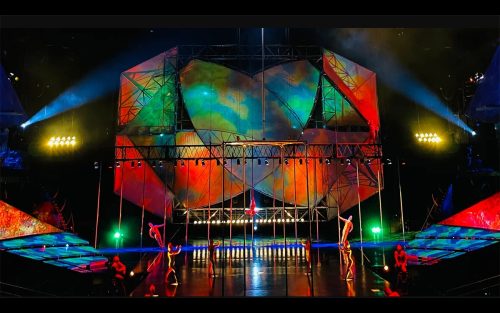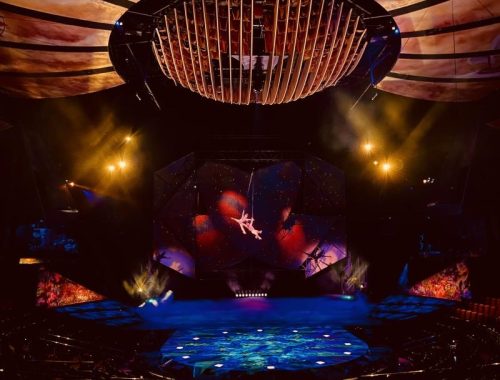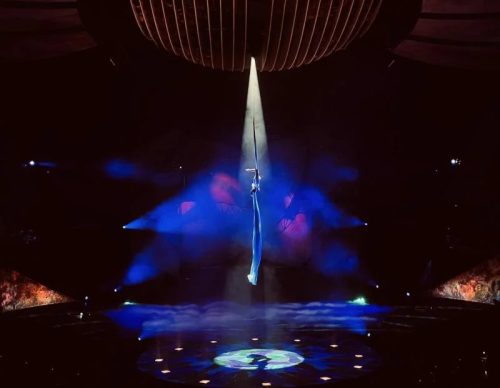By: Luc Lafortune
When Matt Nickel and Michel Laprise [of Cirque Du Soleil] first approached me about relighting Mystère, one of the primary concerns was, by the time we were done, was it still going to look like Mystère, which is now a classic, and of course, we had to be mindful of that. It was important that we retain the aesthetics that were unique to Mystère and not have it look dated or passé, perhaps even stale. The cast is young and very dynamic.
When Sean Jensen [head of lighting, SFX and projection at Cirque du Soleil Mystère] and I started looking at fixtures, we kept a very open mind. Mind you, by the time I got involved, Sean and Patrick Teich, lighting manager for Resident Show Division, had already done a lot of the leg work. Sean Jensen is the head of department for lighting. He’s one of the very few who’s been there since day one.
In early 2023, I traveled to Las Vegas to look at fixtures. Sean and Patrick had organized a demo, in the theatre, and we were able to see exactly how the various fixtures behaved. We looked at color, saturation, evenness, dimming, movement, strobing, all of it. We looked at a number of different manufacturers and we knew that we were going to have to mix and match. The elliposidals and Fresnels were from ETC, the movers from Robe, and the specialty fixtures from Chauvet Professional. These were chosen among other things because of their size. Some fixtures of course didn’t make the cut, not that they were bad. They just wouldn’t have worked in the context of Mystère. After we narrowed it down, and given that we were mixing and matching manufacturers, we then had to see how the various fixtures might coexist. Sometimes, something as simple as color temperature can throw the whole thing off.
We also looked at a bunch of movers. Effects have always been part of Mystère’s DNA and we knew that we had to be able to reproduce most if not all of them. When I specified the gear back in ‘92, I chose mirrors rather than moving heads. I wanted speed, and the mirrors gave me that. Now, given that we were trying to reduce our footprint, I needed a more versatile fixture. So this time, we went with moving heads from Robe. Mystère was one of the first times I worked with gobos. All of my earlier shows were lit mainly with Par 64s. The work I did back in ‘93 was not uninteresting but it was somewhat timid. A few gobos here and there, some of it may even have looked a bit awkward. The relighting of Mystère offered a unique opportunity, one where I could expand on, and refine, what I had started 30 years ago. I didn’t see the need to rethink everything. I just wanted to make it better, but I also wanted to retain that Mystère vibe. There is no other show like it, and it needed to look and feel like Mystère. I didn’t want it to look “new and Improved.”
Back in ‘93, I did a lot of effects. I used them profusely. I think I did that because more often than not, they helped get me out of a jam. However, as with most things, it’s all about nuance, and as much as I like effects, in the end, it’s still about performance and acrobatics. Effects are there to either enhance the performance, by highlighting specific moments and help tell a story, or, by maintaining and accenting rhythm. To the same extent that there’s rhythm in music, there is also rhythm in lighting.
The opening act, for example, is more intimate, and yet the performance and the characters are powerful. When I first saw the act, before we re-lit the show, I was struck by how much I struggled to see the artists. It’s not that it was dark. It wasn’t about intensity but rather visibility. Mystère is not a dark show, au contraire. If anything, there may just have been too much going on. It’s a bit like a recipe with too many ingredients. In the end, it tastes like nothing.
Consequently, one of the things I did was to pull back. Every lighting gesture had to be bold, singular and intentional. It had to have purpose. Singular meant there had to be one, maybe two things going on at any given moment. There was a lot of empty space onstage and I saw no need to fill it or light it, let alone embellish things. If it was pretty, it was out. If there was no need for it, it was gone. What an incredible opportunity though, to relight a show, 30 some odd years after the show opened. More than once, I caught myself thinking I wish I knew then what I know now.
As far as effects go, our biggest concern was whether we were going to able to reproduce all of that flashing and trashing now that we had moving heads rather than mirrors. For the most part yes. There were of course a few effects that we could only mimic, however, with a clever use of prisms and rotation, we came pretty darn close, despite the slower and heavier fixture. It may have looked a bit different but it felt the same, and that’s what mattered.
It wasn’t just effects. At times, there were just too many colors. Mystère is a colorful show. The palette is large and the colors are bold and assertive; greens, blues, yellows, magentas, deep ambers and reds. Over time however, the palette may have gotten a bit too large. Too many pinks and lavenders. Pink is quaint, it’s a compromise, and it looked terribly out of place. Too pretty. So when the time came to specify fixtures, color was also a determining factor. If anything, the colors now are even more saturated. With the older technology, our starting point was always “white light,” which we then affected with a gel or a filter. In that respect, LEDs are different. Everything now was more intense.
When Sean and I started looking at fixtures, we considered the possibility of doing only moving lights, no conventionals. However I felt that if we did, we might alter the lighting in a way where Mystère would no longer be Mystère. There were also certain images that we were simply not going to able to reproduce had we gone full movers. So Sean and I broke down the rig, bit by bit, went through the entire plot, one section at a time and determined which fixtures could be replaced by a mover and which needed to be conventionals. We needed to cover all of our bases and it needed to be seamless. The movers were going to cost us more than the conventionals and I feared that if we went with only movers, we’d have to black out every now and again and reset the fixtures, and I didn’t want that.
We also had to take into consideration the fact that the bulk of the work was going to happen over the two week dark, after which we needed to be up and running, no matter what. There wasn’t a whole lot of time. The crew was going to strike a whole bunch of older fixtures, hang some new ones, assign them and then we’d program like mad. Had we gone with movers and only movers, I don’t think we would have made it. Realizing we’d be needing a top notch programmer, Sean and Patrick reached out to Benny Kirkham. He and I had met years ago, on The Dixie Chicks, so he was accustomed to my way of doing things. Benny was also familiar with the show. He had done some work for us before so of course, that made things a whole lot easier. Matt Frketich, Sean’s assistant was there as well. Matt has got one of those photographic memories. He remembered everything, which actor stands where and how long they’re onstage for and where they exit and on and on.
We were also going to have to rehearse with the artists and make sure everyone was ok with their new lighting. The artists had been told that things would be different when they got back. Julie Maury, the general stage manager, with some help from the coaches, had worked out a schedule where every act was going to be able to train and rehearse before going out onstage. It’s called validation. It’s not as simple as “Hey, here’s your new lighting.” I knew it was a lot to take in, all at once, however over the years, I had made a habit of always sitting with the artists and explaining not only what I had done and what to expect but also how I thought the new lighting might enhance their performance and emphasize their presence. Sharing and listening go a long way. I hadn’t been to Mystère for some time and few of the artists knew me. So admittedly, I was a bit apprehensive but Sean felt confident. He had developed a good rapport with them. For the most part, it went well. There were, of course, a few adjustments but nothing unexpected.
Stay tuned for Part Two of How I Did That: Relighting Mystère
{ SOURCE: Live Design }


